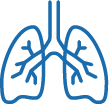Research on 9/11 Health Impacts
After 9/11, health experts began evaluating exposure potential, defining diseases, and studying emerging trends in symptoms and conditions. In 2002, the CDC Agency for Toxic Substances and Disease Registry (ATSDR) and the New York City (NYC) Department of Health and Mental Hygiene (DOHMH) established the World Trade Center Health Registry (the Registry). It became the largest post-disaster health registry in U.S. history, recruiting more than 71,000 voluntary registrants at the close of enrollment in 2004. In 2009, the National Institute for Occupational Safety and Health (NIOSH) began administrating the Registry through the NYC DOHMH. Since inception, the Registry has published over 140 research papers on short- and long-term 9/11 health outcomes.
In addition to the Registry, research projects began to characterize exposures and assess the potential health burden in the 9/11 population. Early efforts examined a broad range of health conditions in both responders and survivors, such as aerodigestive disorders, cancers, and mental health disorders. This research was supported by private and public funds, including federal funding administered by the Centers for Disease Control and Prevention (CDC) and NIOSH. In total, there were 565 articles published in peer-reviewed literature describing 9/11 research prior to the passing of the Zadroga Act.
The Zadroga Act provided funding for a formal 9/11 research program. From 2011-2020, the WTC Health Program has awarded a total of $195.1M for research through contracts, cooperative research agreements, and the Registry ($67.6M). Over 430 peer-reviewed articles have been published from WTC Health Program-funded studies. Annual research funding for long-term physical and mental health effects is authorized until 2090.
The WTC Health Program updates its research agenda to address existing knowledge gaps, investigate the emergence of health conditions linked to 9/11, and build upon current knowledge. Insight from scientists, community members, patients, and other stakeholders continue to shape the WTC Health Program’s research agenda.
Other Resources
Research Timeline
This timeline conveys the history of 9/11 Health Impacts Research efforts to today.
-
Intense, short-term exposure to the dust cloud was associated with cough among FDNY firefighters 
-
After 9/11, residents of Lower Manhattan experienced significantly more upper respiratory symptoms than those in a less-exposed area 
-
People who experienced acute and longer exposures to the dust cloud had a greater risk of asthma and post-traumatic stress disorder (PTSD) symptoms 
-
The first longitudinal cancer study of 9/11 responders described excess cancer risk potentially related to 9/11 exposures among firefighters 
-
Respiratory symptoms were associated with dust cloud exposure among younger children and with 9/11-related stress symptoms among adolescents 
-
The degree and associations of long-term PTSD among responders were demonstrated 
Bromet et al., 2016. Psychol Med.
The association of PTSD and major depressive disorders with cognitive impairment of WTC responders examined 
-
Presence of small airway dysfunction and 9/11-related PTSD were independently associated with persistent lower respiratory symptoms (LRS) among civilians 
-
Study of WTC Health Registry enrollees showed that those with 9/11-related PTSD or intense dust exposure may have an increased risk of stroke 
-
16-year longitudinal study found elevated risk of cardiovascular disease (CVD) among male FDNY firefighters with greater WTC exposure 
-
Our research efforts are ongoing.
Page Last Reviewed: October 23, 2023 | Page Last Updated: October 22, 2024
